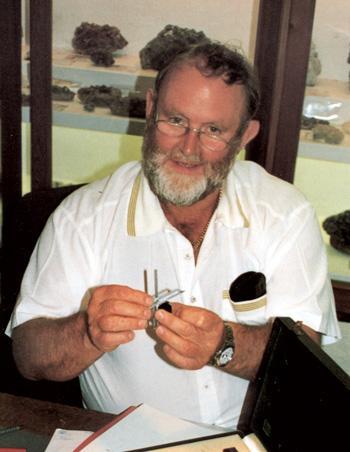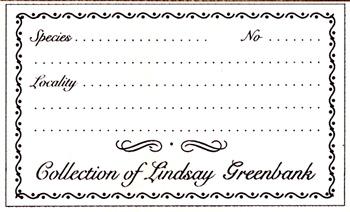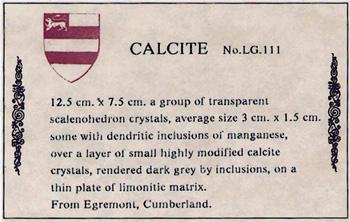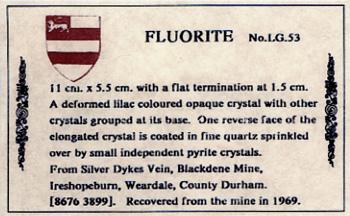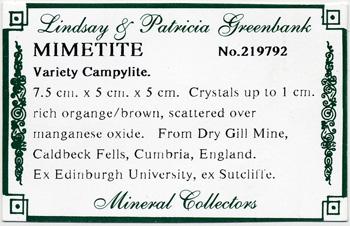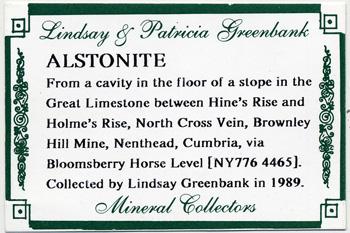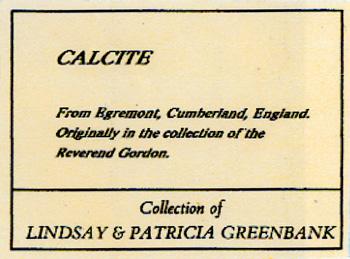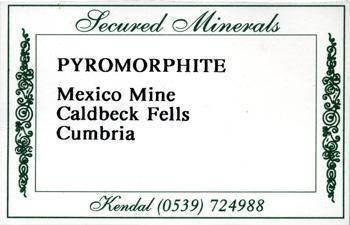Greenbank, Lindsay (1941- )
Lindsay Greenbank, prominent British mineral collector and dealer, was born July 11, 1941 in Kendal, Cumbria, England, the son of Mary and Nelson Greenbank, a self-employed businessman. He was raised and educated in Kendal and left school at the age of 15 to join his two older brothers in the family businesses of farmland management, metal brokering and tire sales. He was fascinated with the underground as a boy, especially after seeing mineral specimens in a neighbor's garden. In his mid teens, he became a serious caver. On a Speleological Expedition to Arctic Norway in 1961 he collected his first specimens (garnets in mica schist) from outcrops on the mountainside. In 1963, in Cigalere cave in the Pyrenees, Lindsay saw for the first time huge gypsum crystals in the caverns and felt the urge to collect mineral specimens (strictly forbidden in caving!). When he returned home from this expedition he gave up caving in favor of mineral collecting.Lindsay's first mineral collecting partner was Tony (Walter) Walshaw, in the early to mid 1960's, and their friend and mentor William F. (Bill) Davidson (1907-2002) of Penrith, Cumbria. Davidson, an avid collector and dealer, was generous with advice on where to collect and gave them assistance with identifying their finds. It was also in the mid 1960's that Lindsay and Tony met Ralph Sutcliffe at the Brandy Gill mine in Cumbria; the four began collecting together occasionally and became lifelong friends.
Around the mid 1960s Lindsay started to augment his field collecting by buying specimens from miners working at the Blackdene mine, the Groverake mine and others in the Weardale district, and also from miners at the Settling Stones mine in Northumberland. In 1968 Patricia Knowles became Lindsay's collecting partner, and they were married in 1973. With Michael (Mick) and Brenda Sutcliffe they spent much time underground in the Hilton mine and the mines of Alston Moor, including the Nentsberry Haggs, Brownley Hill and Smallcleugh mines. They explored the mines of the Caldbeck Fells, digging out collapsed entrances at the Brandy Gill mine, the Mexico mine, and others. In 1969 Lindsay and Patricia holidayed in Europe, selling specimens in Idar-Oberstein to cover the cost; this marked the start of their mineral dealing business.
Another great mentor who gave generous help was William T. (Bill) Shaw of Keswick, the surveyor of the Force Crag mine in the Lake District. Bill invited Lindsay and Patricia to collect from a large cavity which had just been encountered in the roof; they recovered many groups of snow-white barite from the pocket.
In 1970 Lindsay and Mick decided to operate the Dry Gill mine commercially for specimens. With Patricia and Brenda they formed the Cumbria Mining and Mineral Company, registering the company in London in 1972. Unfortunately their application to the owners of the mineral rights was refused, and so the new specimen mining company obtained a license to open a previously unworked fluorite vein in the Rogerley quarry in Weardale. The Rogerley mine became the first commercial mine in the country to be exploited exclusively for mineral specimens.
In 1982 Lindsay and Mick with two other partners, Peter Blezard and Anne Danson, formed the New Coledale Mining Company, Ltd. and took on another mining project at the Force Crag mine near Keswick in the Lake District, but it closed in 1990. For years Lindsay had sought to relocate the original occurrence of the mineral alstonite, finally succeeding in 1987 at the Brownley Hill mine. In 1988-1990 the mines of Weardale yielded many fine specimens, mostly fluorites from the Frazer's Hush mine and the Cambokeels mine, but also calcites, galenas and rare pyrrhotites. Patricia made many journeys to Weardale buying specimens from all the miners. From the 1970s on, most of the mineral dealing by the Cumbria Mining and Mineral Company has been done from Kendal, but they also attended the major British mineral shows. Lindsay and Patricia established a second mineral dealership called Secured Minerals, and regularly attended the shows in Munich, Sainte Marie aux Mines, Turin, Springfield and Tucson.
Lindsay was involved in the purchase and dispersal of the Anthony Walshaw mineral collection in 1989, the collection of Ralph Sutcliffe in 1991, the Leadhills-Wanlockhead collection of Nick Carruth in 1994, and the small Greenbank-Behier Leadhills-Wanlockhead collection. Specimens from the Sutcliffe and Carruth collections are illustrated in Minerals of Scotland Past and Present by Dr.Alec Livingstone. The Derbyshire content of Ralph's collection was sold to the Derby Museum.
Secured Minerals became the vehicle for purchasing many classic British specimens abroad for Lindsay's personal collection. When Dick Barstow died in 1982, Ralph Sutcliffe was able to purchase from his widow some of the specimens from his collection, adding them to his own; In 1991 Lindsay acquired Ralph Sutcliffe's collection. By this time the Greenbank Collection had come to be recognized as one of the finest private mineral collections in Britain. Exhibits from the collection have since been shown at the Springfield show, the Tucson Show and twice at the Munich Show. Greenbank specimens have been illustrated in numerous publications, including Mick Cooper's 1997 book about Lindsay's collection, Classic Minerals of Northern England (printed in Kendal in a limited edition of 50 copies), as well as The UK Journal of Mines and Minerals, Matrix, Lapis, Rocks & Minerals, and the book Minerals of the English Lake District – Caldbeck Fells.
Unfortunately, Lindsay suffered an overwhelming illness in 1996 which put a stop to business and forced the suspension of mining operations at the Rogerley mine; in 1998 the decision was made to sell off the mine and also the mineral collection. The American team UK Mining Ventures took over the Rogerley project. Although Lindsay had hoped that a British institution could acquire his collection in its entirety, including the considerable associated documentation (mine plans and sections, letters and other documents and ephemera), efforts to that end were unsuccessful. So it was decided to break up the collection for sale. A small sub-collection of fluorites passed to the Royal Museum in Scotland, and since then other small sub-collections and individual pieces have also been sold to various buyers. But the major part of the collection was still intact in 2008 when American dealer Rob Lavinsky visited Kendal and purchased about half of the remaining collection, including some of the most important specimens. Despite this sale, Lindsay and Patricia still retain many good specimens in Kendal. Four different collection labels have been used over the years.
Lindsay's other collections include faceted fluorites from the north of England, scientific instruments and earth science related items. He also has a collection of around 200 vintage corkscrews. Lindsay has lived at only two addresses – with his parents at 12 Finley Drive in Kendal and with Patricia (and son Oliver, born in 1985) at Birchfield, 16 Sedbergh Road in Kendal.
Click to images to view larger
To contribute more information please E-mail us at:
minrecord@comcast.net
Citation format for this entry:
WILSON, Wendell E. 2022
Mineralogical Record
Biographical Archive, at www.mineralogicalrecord.com
minrecord@comcast.net
Citation format for this entry:
WILSON, Wendell E. 2022
Mineralogical Record
Biographical Archive, at www.mineralogicalrecord.com

